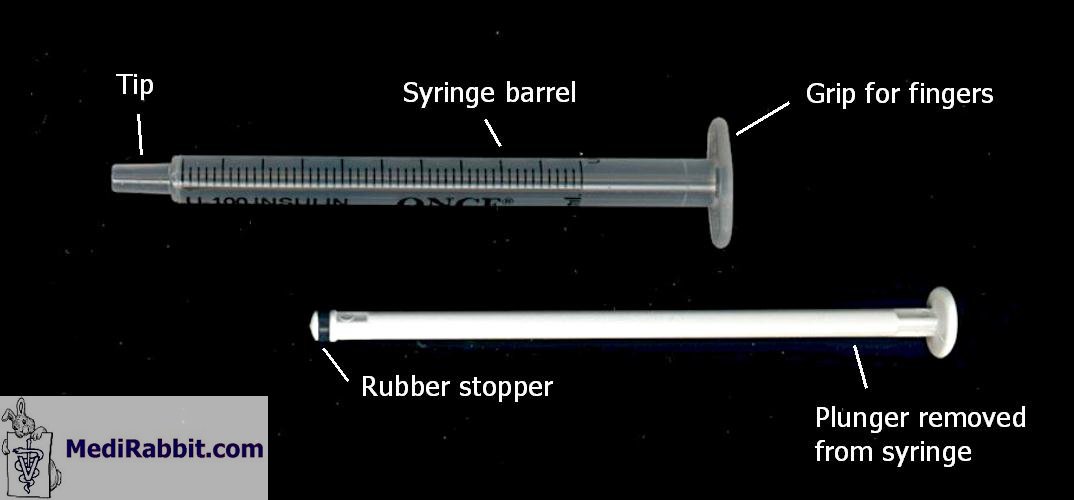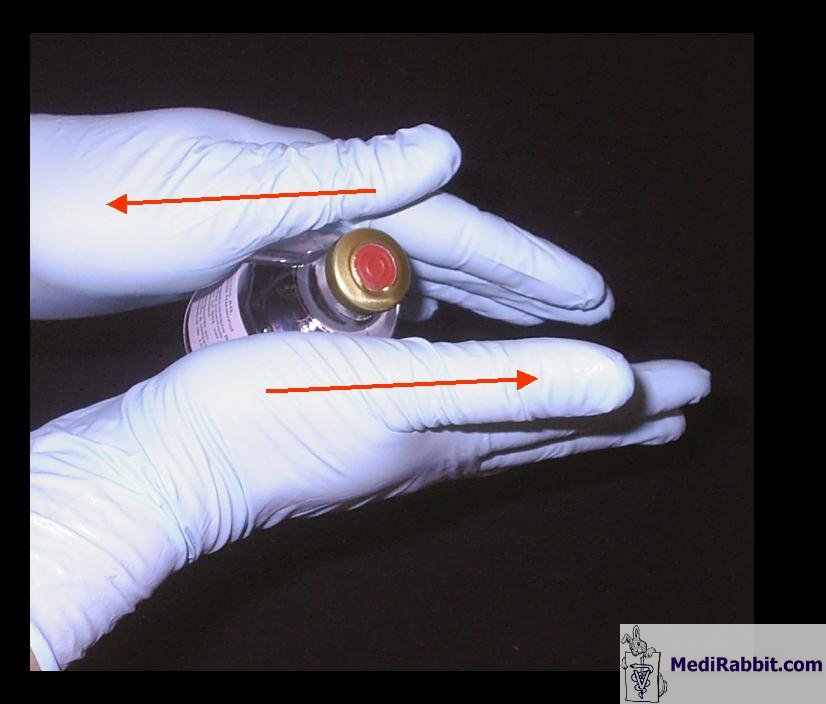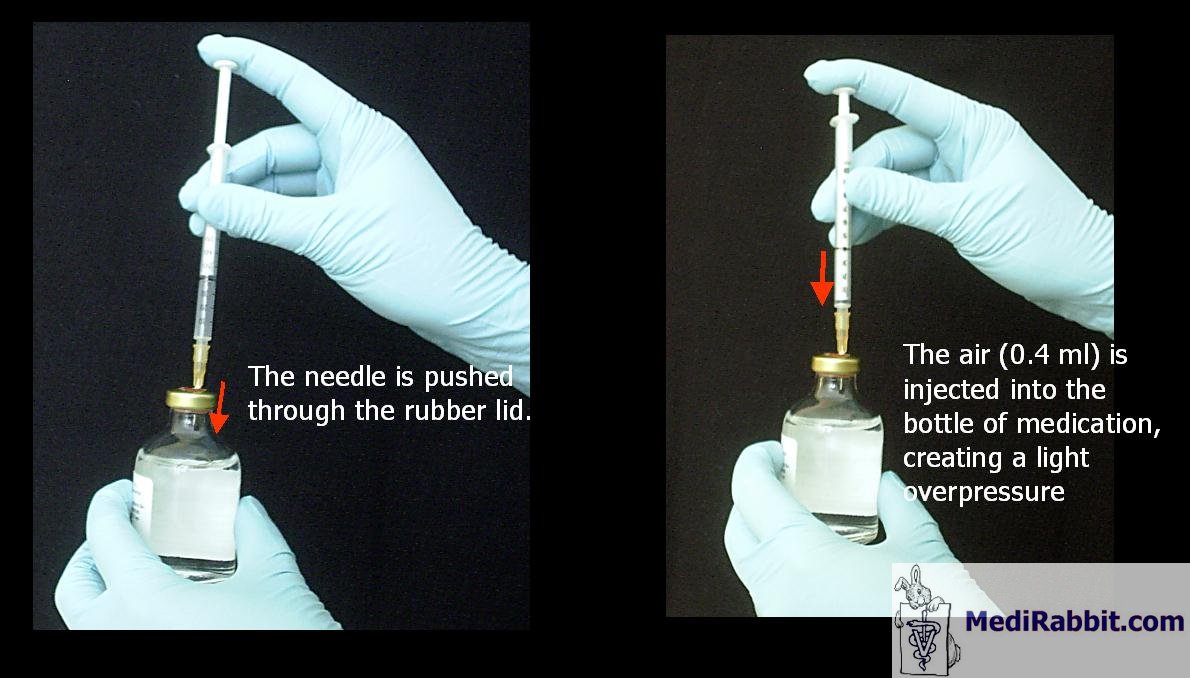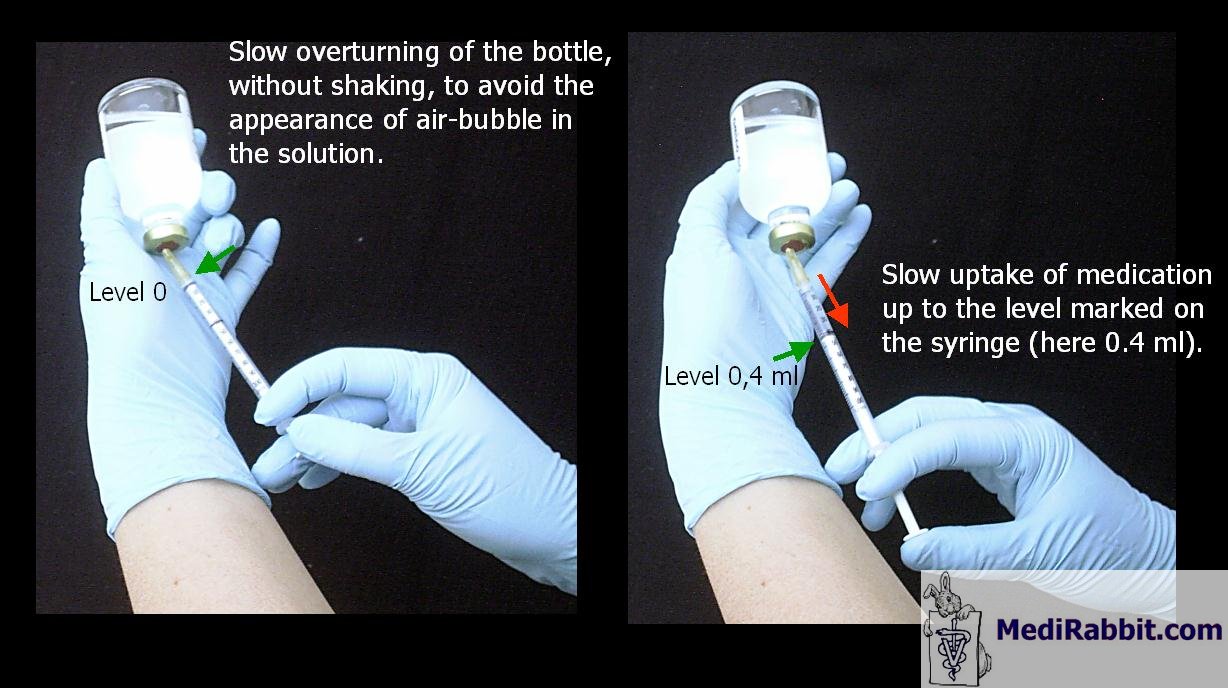Basic
instructions for subcutaneous injections in rabbits
Naomi Heinsma
|
MediRabbit.com is
funded solely by the generosity of donors. Every
donation, no matter what the size, is appreciated and will aid in the continuing
research of medical care and health of rabbits. Thank you |
|
Before giving medication to a
rabbit, the nursing person should prepare the needed material and relax as
much as possible. Indeed, rabbits can sense nervousness and stress and will
be tense or run away when the person approaches to give the medication. On a table prepare: • The medication, • The syringe, packed in a sterile plastic, • The sterile new needle (gauge 23-27),
protected in the needle cap.
Drawing medicine from a sealed bottle or glass vialVarious medications, like antibiotics, are available
in sterile injectable liquid solutions, stored in glass or plastic vials
closed with a rubber stopper and sealed with an aluminum ring. The sealing
and stopper should never be removed. Indeed, once the vial opened, the
solution is not sterile anymore.
Before taking the right amount of
medication out of the bottle, the medication needs to be mixed in the vial or
to be warmed up, if stored in the refrigerator. Take the vial and roll it
gently between the palms of the hand. During this step, the bottle containing
the medication should never be shaken. This will cause: • The formation of bubbles that make
extracting the medication harder, • The inability to get an accurate
measurement, • The addition of air into the volume of medication
to be given, decreasing the effective dosage, • The presence of air in the subcutaneous
tissue, after injection. When the bottle is new and used
for the first time, the protective aluminum cover must be broken off. It is
then verified that the appropriate sterile needle and syringe are used. It is
possible to use the same needle to withdraw the medication from the vial, and
later inject it to the rabbits. Some, however, prefer to use a separate
needle to extract the necessary volume of medication from the bottle. It is necessary to clean the outer
surface of the rubber lid with a cotton ball drenched in a 70% alcohol
solution. This ensures that the outer surface of the rubber lid is
sterilized, so that no microbes are imported into the bottle and will
contaminate the solution. DO NOT TOUCH the lid with fingers afterwards!!! It is important to know the volume of medication
that needs to be extracted from the bottle and to check if this can be drawn
with the syringe. To avoid mistakes, a mark can be made on the syringe barrel
with a pen writing on plastic, so to mark the level
up to where the plunger must be pulled back (see illustrations).
The first step in taking medication is to pull the
plunger back to the amount (ml, cc or units, or the mark made on the syringe)
needed. This will fill the syringe with air. The protective cap of the needle
is now removed. DO NOT TOUCH the needle with fingers afterwards!!! Make sure you know what size the syringe is and
where you want the dosage to be drawn to.
I usually pull back on the plunger to the cc line of the dosage, then
I stick the needle into the rubber cap of the bottle and tip the bottle at an
angle, and push the plunger injecting a bit of air into the bottle. I then pull back on the plunger slowly
getting a bit more meds than is necessary and pull the needle out. I then push on the plunger of the syringe
making sure to get rid of bubbles and getting to the exact cc/mm line of how
much meds are needed. I have separate syringes for each rabbit and have the
dosage lines marked on each syringe depending on the amount needed.
Giving the InjectionOnce you have extracted the meds
and changed the needle (if that's how what you choose to do) then lift up on
the rabbit's skin to make a mountain or 'tent' out of the skin. Also, make sure you insert the
needle with the opening facing upwards towards you. This will make inserting the needle into
the skin easier. When you insert the needle do so
at a 45° angle, do not stick the needle into the skin at any higher angle or
the needle will go out the other side of the skin. Rabbits have very thin skin so this is a
real possibility. To make sure you haven't
accidentally poked the needle through to the other side, check the rabbit's
skin afterwards to see if it is wet.
If so, you may not have delivered the meds into the rabbit, but shot
them out the other side. Before injecting the meds into the rabbit, be sure
to aspirate or draw back on the needle plunger to make sure you do not draw
up blood. If you do, pull the needle
out immediately and try inserting again in another area. Blood in the needle usually means you have
the needle in a vein or in the muscle; this is not where you want the needle.
I often use a 10-15 gallon storage container to give
shots. I put blankets/towels in the
bottom and the rabbit on top of these.
The rabbit is contained and isn't generally able to jump out or move
around. If you are giving shots or subq fluids alone, this is much easier for you and less
stressful on the rabbit. Make sure you
do this in a safe, bunny proofed room.
|
e-mail: info@medirabbit.com










